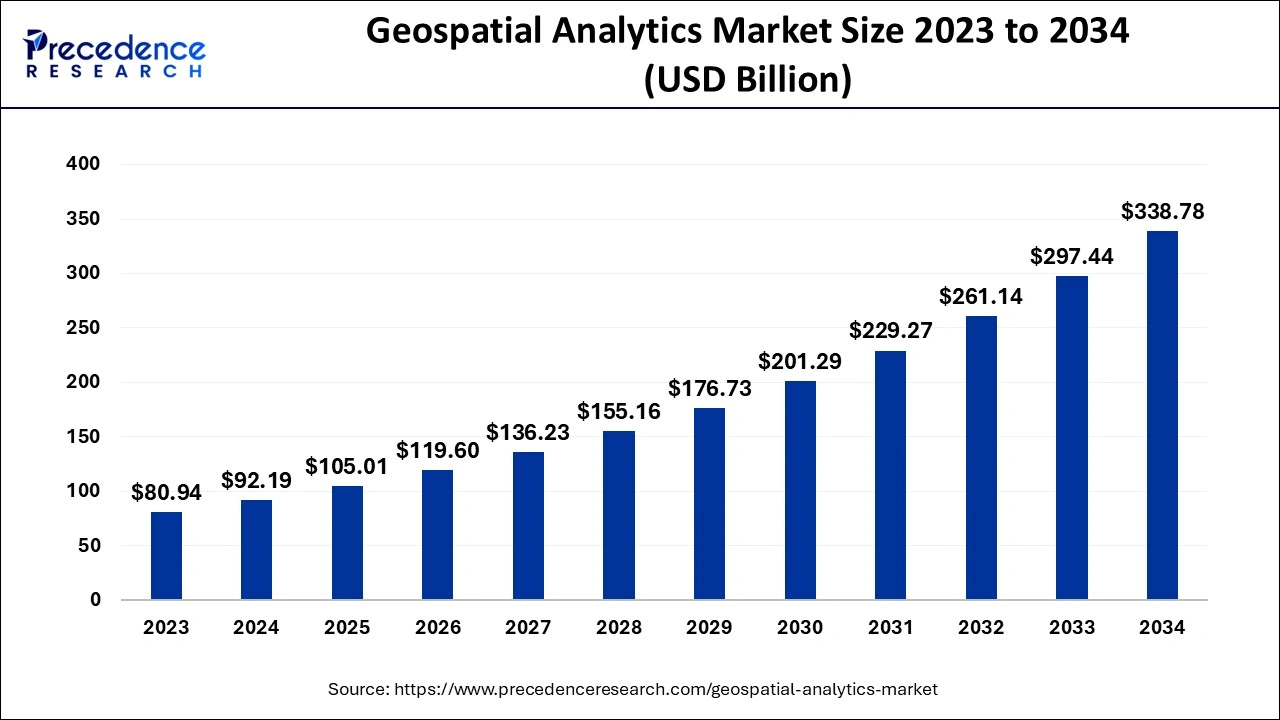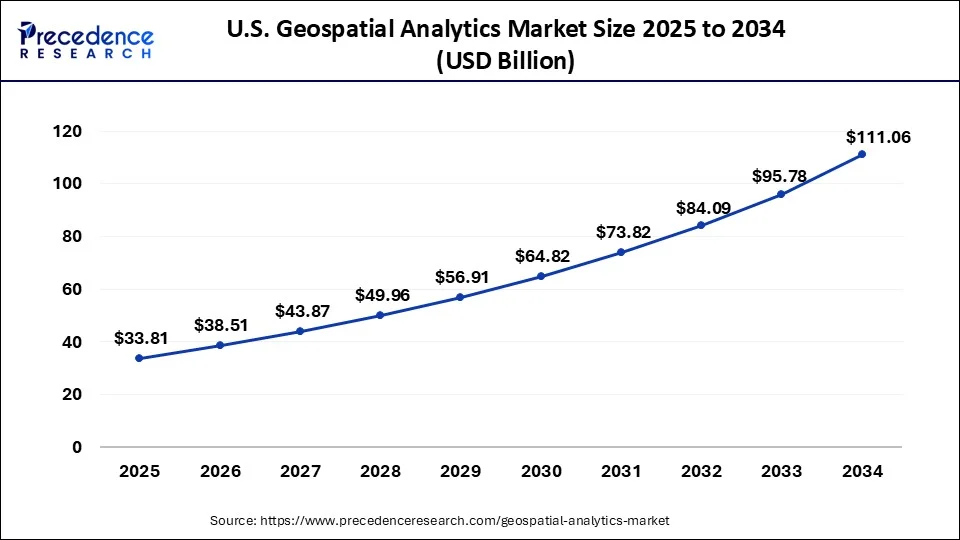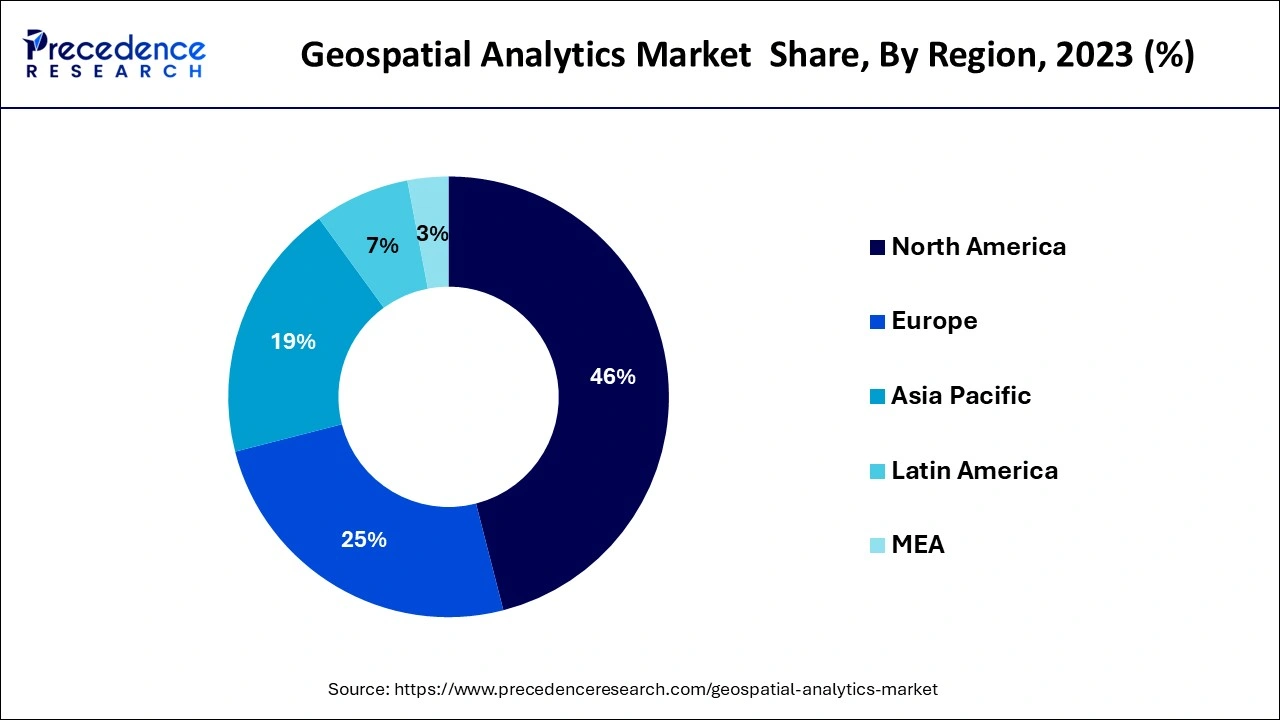October 2024
The global geospatial analytics market size accounted for USD 92.19 billion in 2024, grew to USD 105.01 billion in 2025 and is predicted to surpass around USD 338.78 billion by 2034, representing a healthy CAGR of 13.90% between 2024 and 2034. The North America geospatial analytics market size is calculated at USD 42.41 billion in 2024 and is expected to grow at a fastest CAGR of 14.01% during the forecast year.
The global geospatial analytics market size is accounted for USD 92.19 billion in 2024 and is anticipated to reach around USD 338.78 billion by 2034, growing at a CAGR of 13.90% from 2024 to 2034.

The U.S. geospatial analytics market size is evaluated at USD 29.69 billion in 2024 and is predicted to be worth around USD 111.06 billion by 2034, rising at a CAGR of 14.09% from 2024 to 2034.

Asia-Pacific dominated the geospatial analytics market in 2023. China and India dominated the geospatial analytics market in Asia-Pacific region. The growth of geospatial analytics market in Asia-Pacific region is being driven by the growing government initiatives. The Chinese government launched its first thorough geography census in 2018. It will be used to report on the country's overall position as well as statistics on land and soil, water, and agriculture, which will serve as a firsthand reference for policies. In addition, the growing trend of mobility as service facility is also boosting the growth of Asia-Pacific geospatial analytics market. Morgan Stanley estimates that shared miles will account for 35 percent of all miles travelled in India. Along with a continuing huge shift in terms of electrification, sharing, and connectivity, this is one of the primary driving opportunities for new business models in the mobility business.

North America, on the other hand, is expected to develop at the fastest rate during the forecast period. The U.S. dominates the geospatial analytics market in North America region. One of the key drivers driving the growth of North America geospatial analytics market is the growing adoption of innovative and latest technologies such as internet of things, big data analytics, artificial intelligence, and cloud computing. Furthermore, the rising demand for high-speed internet is also supporting the growth of North America geospatial analytics market.
One of the significant factors driving the global geospatial analytics market is the technological developments. Kongsberg Geospatial, an Ottawa-based creator of mission-critical and real time geospatial visualization solution and software, and CarteNav Solutions, a foremost supplier of situational consciousness solutions for the land, maritime, and air environments, recently announced that CarteNav had chosen their TerraLens platform to provide geospatial capabilities for its new generation of AIMS mission system software. The demand for services that leverage location-based solutions is likely to rise as smart city investments increase. Furthermore, according to the Consumer Technology Association, smart city spending reached USD 14.85 billion in 2015 and is expected to reach USD 34.35 billion by 2020.
There is a strong demand for the implementation of 5G technology in order to capture precise geographical data. Geospatial analytics vendors are seeing significant growth prospects. The market is developing on three primary spectrum bands such as low, mid, and high. As the 5G infrastructure takes shape, there is a growing demand for geospatial technology in a variety of industries. All of these elements are contributing to the growth of the geospatial analytics industry. The market is predicted to increase significantly throughout the forecast period, thanks to increasing penetration and adoption of the internet of things around the world, as well as the advent of artificial intelligence and big data analysis.
| Report Coverage | Details |
| Market Size in 2024 | USD 92.19 Billion |
| Market Size by 2034 | USD 338.78 Billion |
| Growth Rate from 2024 to 2034 | CAGR of 13.90% |
| Base Year | 2023 |
| Forecast Period | 2024 to 2034 |
| Segments Covered | Component, Type, Solution, Technologies, Deployment Mode, Organization Size, Application, and Geography |
The software segment dominated the geospatial analytics market in 2023. Enterprises can use geospatial analytics software to locate, evaluate, and respond to changing business circumstances and trends. The market players have commenced to involve in geospatial analytics in order to enhance suppleness and overall operational output, better comprehend business trends, and reduce expenses. The software sector can be thought of as the most advantageous component for generating high-level insights from location data.
The service segment is the fastest growing segment of the geospatial analytics market in 2023. Analytics are being used by government agencies and public safety organizations to monitor natural resources, infrastructure projects, detect cross-border incursions, and improve vehicle safety and security. Businesses are also providing Geospatial Analytics-as-a-Service.
The surface and field analytics segment dominated the geospatial analytics market in 2023. The growth of surface and field analytics segment is attributed to the rising acceptance and adoption by private and government firms. In addition, the growing number of infrastructure development projects are also supporting the growth of the overall market.
The network and location analytics segment is fastest growing segment of the geospatial analytics market in 2023. The technology aids in the improvement of data analytics' functionality, utility, and relevance. It can also analyze and organize enormous amounts of data in real time in order to obtain actionable business insights. It also enables marketers to visualize, comprehend, and interpret data in a variety of ways to demonstrate links, trends, and patterns using globes, maps, charts, and reports. This is critical for every business that wants to grow, expand into new markets, and satisfy customers.
The military intelligence segment dominated the geospatial analytics market in 2023. Strategic intelligence plays an important role in modern military strategies. Strategic intelligence relies heavily on geospatial data. Many countries are constantly strengthening their military as a result of current military confrontations between big economies. Border security operations can use geospatial data to give situational awareness information, enabling quick decision-making, and improve national security.
The surveying segment is fastest growing segment of the geospatial analytics market in 2023. This is due to its widespread adoption in agricultural and natural resource monitoring. During the projected period, however, the military intelligence segment is expected to increase at the quickest rate. This could be due to an increase in the number of remote sensing satellites used for border patrols around the world, necessitating the usage of geospatial analytics.
By Component
By Type
By Solution
By Technologies
By Deployment Mode
By Organization Size
By Application
By Geography
For inquiries regarding discounts, bulk purchases, or customization requests, please contact us at sales@precedenceresearch.com
No cookie-cutter, only authentic analysis – take the 1st step to become a Precedence Research client
October 2024
August 2024
July 2024
August 2024